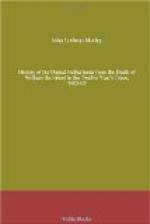The stadholder, against his will—for Maurice was never cruel—felt himself obliged to teach the cardinal better jurisprudence and better humanity for the future. In order to show him that there was but one belligerent law on sea and on land, he ordered two hundred Spanish prisoners within his lines to draw lots from an urn in which twelve of the tickets were inscribed with the fatal word gibbet. Eleven of the twelve thus marked by ill luck were at once executed. The twelfth, a comely youth, was pardoned at the intercession of a young girl. It is not stated whether or not she became his wife. It is also a fact worth mentioning, as illustrating the recklessness engendered by a soldier’s life, that the man who drew the first blank sold it to one of his comrades and plunged his hand again into the fatal urn. Whether he succeeded in drawing the gibbet at his second trial has not been recorded. When these executions had taken place in full view of the enemy’s camp, Maurice formally announced that for every prisoner thenceforth put to death by the archduke two captives from his own army should be hanged. These stern reprisals, as usual, put an end to the foul system of martial murder.
Throughout the year the war continued to be exclusively the siege of Ostend. Yet the fierce operations, recently recorded, having been succeeded by a period of comparative languor, Governor Dorp at last obtained permission to depart to repair his broken health. He was succeeded in command of the forces within the town by Charles Van der Noot, colonel of the Zeeland regiment which had suffered so much in the first act of the battle of Nieuport. Previously to this exchange, however, a day of solemn thanksgiving and prayer was set apart on the anniversary of the beginning of the siege. Since the 5th of July, 1601, two years had been spent by the whole power of the enemy in the attempt to reduce this miserable village, and the whole result thus far had been the capture of three little external forts. There seemed cause for thanksgiving.
Philip Fleming, too, obtained a four weeks’ holiday—the first in eleven years—and went with his family outside the pestiferous and beleaguered town. He was soon to return to his multifarious duties as auditor, secretary, and chronicler of the city, and unattached aide-de-camp to the commander-in-chief, whoever that might be; and to perform his duty with the same patient courage and sagacity that had marked him from the beginning. “An unlucky cannon-ball of the enemy,” as he observes, did some damage at this period to his diary, but it happened at a moment when comparatively little was doing, so that the chasm was of less consequence.




